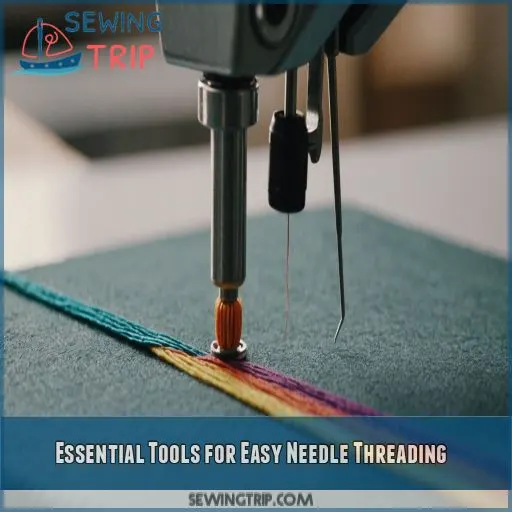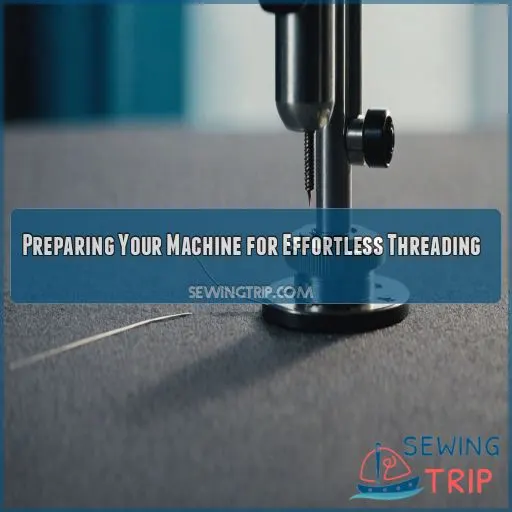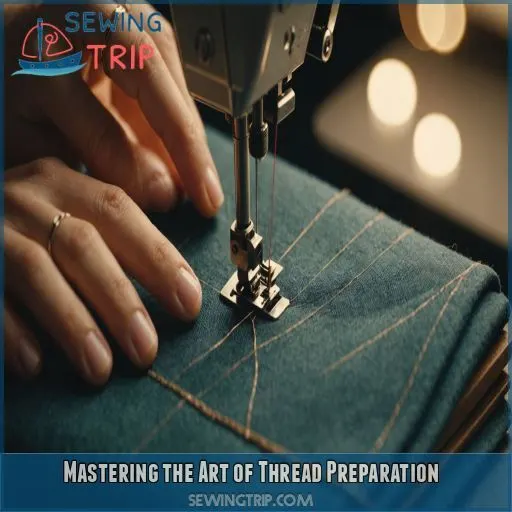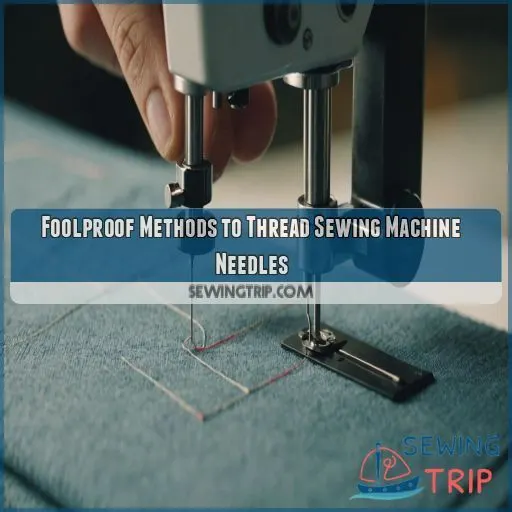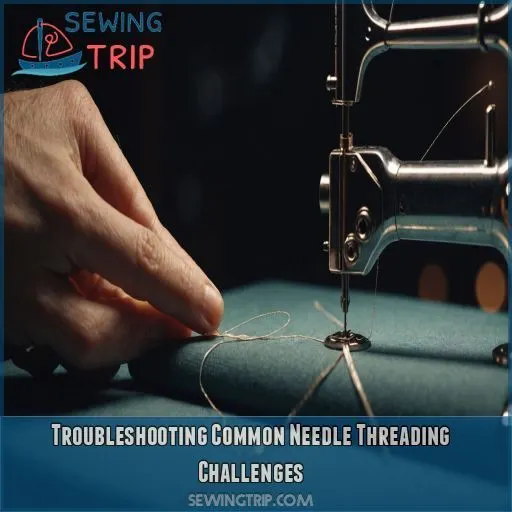This site is supported by our readers. We may earn a commission, at no cost to you, if you purchase through links.
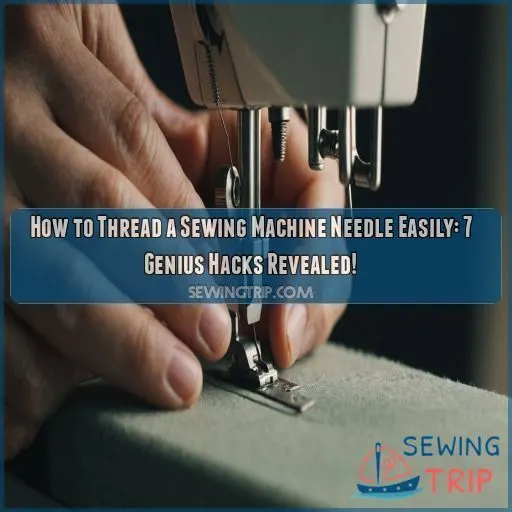
With a few clever tricks up your sleeve, you’ll be threading like a pro in no time.
Start by investing in quality needles and a handy Needle Threader – your eyes will thank you.
Prep your thread by trimming it cleanly and giving the tip a quick lick (yes, really!).
Raise that needle to its highest point and turn off your machine to avoid any accidental stitches.
For the threading itself, try the twist-and-loop method or let your machine’s automatic threader do the heavy lifting.
Stuck? Don’t sweat it – we’ve got more genius hacks to make threading a breeze.
Table Of Contents
Key Takeaways
- Invest in quality needles and a needle threader – your eyes will thank you (and you’ll save a few grey hairs)! High-quality sewing machine needles can make all the difference in effortless threading.
- Proper lighting is your new sewing BFF! Grab a good sewing lamp or DIY a solution to prevent eye strain, and you’ll be threading needles like a pro.
- Thread conditioners and smoothing agents can tame even the most stubborn threads. Ditch the frustration and whip out the big guns – Thread Magic or a DIY beeswax solution to the rescue!
- Automatic threaders and self-threading needles are the secret ingredients in the ultimate threading recipe. Master these nifty tools and techniques, and you’ll be zipping through threads in no time!
Essential Tools for Easy Needle Threading
Threading a sewing machine needle doesn’t have to be a frustrating experience if you’ve got the right tools at your fingertips. From high-quality needles to clever threading gadgets, we’ll explore the must-have items that’ll transform your needle threading from a chore into a breeze.
High-quality Sewing Machine Needles
You’re only as good as your tools! Invest in really good sewing machine needles and you’ll breeze through threading. Choose the right size and type for your fabric, and you’ll be stitching like a pro in no time.
Needle Threaders and Inserters
You’ll love needle threaders and inserters – they’re your secret weapon for hassle-free sewing! These nifty tools come in various types and materials, making threading a breeze. Say goodbye to squinting and frustration!
Proper Lighting and Magnification Tools
You’ll feel like a sewing superhero with proper lighting and magnification! Invest in a good sewing lamp or try a DIY solution. Your eyes will thank you, and threading needles becomes a breeze.
Thread Conditioners and Smoothing Agents
Ever wrestled with stubborn thread? Thread conditioners are your secret weapon! These miracle workers smooth fibers, reduce tangling, and make threading a breeze. Try Thread Magic or whip up a DIY version with beeswax.
Sharp Scissors for Clean Thread Cuts
You’ll want to keep your scissors sharp as a tack! Dull blades create frayed ends, making threading a nightmare. Invest in quality scissors specifically for sewing—your future self will thank you!
Preparing Your Machine for Effortless Threading
You’ve got your thread and needle ready, but is your sewing machine prepped for action? Let’s set the stage for threading success with a few simple tweaks that’ll make your life a whole lot easier.
Raising the Needle to Its Highest Position
Now that you’ve got your tools ready, let’s set the stage for threading success. First up: raising that needle to its highest position. It’s like giving your machine a little stretch before the main event!
Turning Off the Machine for Safety
Before you start threading, hit that power switch! It’s like putting your sewing machine to sleep – no unexpected movements or accidental stitches. Trust me, your fingers will thank you for this simple safety step. Peace of mind, guaranteed!
Lowering or Removing the Presser Foot
Lower that presser foot, and you’re halfway there! It’s like opening the gates to threading paradise. For even more elbow room, pop it off entirely. You’ll feel like a sewing superhero with all that space!
Adjusting Machine Settings for Optimal Threading
Let’s get your sewing machine humming along smoothly. Here’s a quick plan to make threading a breeze:
- Check thread tension
- Adjust needle position
- Make sure the bobbin is wound correctly
- Align the needle plate
Mastering the Art of Thread Preparation
You’re almost ready to thread that needle, but first, let’s whip that thread into shape! With a few simple tricks, you’ll transform your unruly thread into a sleek, cooperative partner that’ll glide through the needle’s eye like a hot knife through butter.
Cutting Thread Ends Cleanly and Precisely
You’ll want to snip those thread ends like a pro. Grab your sharpest scissors and make a clean cut at a slight angle. No fraying allowed—it’s the first step to threading success!
Moistening Thread Tips for Smoother Insertion
You’ve got the thread, but it’s being stubborn? Don’t sweat it! A little moisture can work wonders. Here’s how to lubricate your thread for smoother sailing:
- Lick it (yes, really!)
- Dab with water
- Use a damp sponge
- Try a specialty thread lubricant
These tricks reduce friction, making threading a breeze. It’s like giving your thread a slippery superhero cape!
Using Thread Conditioners for Strength and Smoothness
Ever wrestled with unruly thread? Enter thread conditioners, your new best friend! These magical potions smooth and strengthen your thread, making needle-threading a breeze. Apply a dab and watch your sewing game level up!
Shaping Thread Ends for Easier Eye Penetration
Ever battled with a stubborn thread? Shape it like a pro! Pinch the end, roll it between your fingers, and voilà – a neat, pointed tip ready to glide through that pesky needle eye.
Choosing the Right Thread Thickness for Your Needle
- Thread Size Chart: Your go-to cheat sheet
- Fabric Weight: Light fabrics need thin threads
- Needle Gauge: Thicker needles love chunky threads
- Thread Types: Cotton, polyester, or silk? Choose wisely!
- Sewing Tension: The Goldilocks zone – not too tight, not too loose
[/OUTPUT]
Foolproof Methods to Thread Sewing Machine Needles
Threading a sewing machine needle doesn’t have to be a frustrating ordeal. With these foolproof methods, you’ll be threading like a pro in no time, whether you’re using your hands, nifty tools, or your machine’s built-in features.
Hand Threading Techniques for Precision
Ready to master hand threading? Here’s the scoop: Hold the needle steady, aim the thread like a sharpshooter, and gently push it through. Practice makes perfect, so don’t sweat it if you miss!
Using Needle Threading Tools Effectively
Needle threading tools are your secret weapon for hassle-free sewing. These nifty gadgets make threading a breeze, even for those with shaky hands or less-than-perfect eyesight. Here’s how to use them like a pro:
- Choose the right tool for your needle size
- Keep your threader clean and sharp
- Practice the motion to build muscle memory
Leveraging Automatic Needle Threaders on Machines
If your machine has an automatic threader, you’re in luck! This nifty feature can save you time and frustration. Let’s explore how to make the most of this handy tool.
Working With Self-threading Needles
If automatic threaders aren’t your cup of tea, self-threading needles might be your new best friend. These clever needles have a small slit that guides the thread into place effortlessly.
Employing the Twist and Loop Method
Now that you’ve mastered self-threading needles, it’s time to learn the twist and loop method. This technique requires some finesse, but with practice, you’ll be a pro!
- Twist the thread around the top of the needle, leaving a small loop.
- Pinch the loop and gently guide it through the needle’s eye.
- Use a steady hand to pull the thread through, keeping it taut.
- Once the thread is securely in place, trim the excess and start sewing!
Troubleshooting Common Needle Threading Challenges
Even the most experienced sewers encounter threading hiccups from time to time. Let’s tackle some common needle threading challenges head-on, so you can get back to your sewing projects without pulling your hair out.
Dealing With Frayed Thread Ends
Frayed threads giving you a headache? Don’t fret! Grab your sharpest scissors and snip those pesky ends. A dab of moisture or thread conditioner can work wonders. You’ll be threading like a pro in no time!
Overcoming Poor Visibility Issues
- Grab a desk lamp and position it just right
- Slap on those reading glasses (no shame in the game!)
- Invest in a nifty magnifying glass with built-in LED lights
- Place a white sheet of paper behind your needle for contrast
These visibility boosters will have you threading like a pro in no time. Remember, good lighting isn’t just for vampires – it’s a sewer’s best friend too!
Managing Difficult-to-thread Needle Eyes
Struggling with stubborn needle eyes? Don’t fret! Try a larger needle size or switch to a self-threading needle. Use magnification tools and thread conditioners for smoother sailing. You’ve got this, sewing superstar!
Addressing Thread Tension Problems
- Check bobbin tension
- Match needle size to fabric
- Adjust upper thread tension
- Test on scrap fabric
Let’s conquer those tangles!
Solving Machine-specific Threading Obstacles
Got machine issues? Don’t throw in the towel! Each sewing machine brand has its quirks. From needle jams to bobbin blues, we’ll tackle those pesky problems together. You’ll be stitching up a storm in no time!
Frequently Asked Questions (FAQs)
How do you use a needle threader?
Imagine this: you’re wielding a tiny wire loop, ready to conquer that pesky needle eye. You’ll slip the loop through, catch your thread, and pull it back. Voila! You’ve mastered the art of effortless threading.
How to thread a sewing machine?
You’ll breeze through threading your sewing machine in no time! Start by raising the needle, then guide the thread through the upper tension disc, take-up lever, and needle bar. Finally, slip it through the needle’s eye.
How do you use a sewing needle?
Imagine the power in your hands! You’ll use a sewing needle to join fabrics, create patterns, and mend clothes. Hold it firmly, insert thread through the eye, and push it through fabric layers. Pull thread to form stitches.
What direction should a sewing machine needle be threaded?
You’ll want to thread your sewing machine needle from front to back. It’s like threading a tiny hoop! Slip the thread through the eye, pulling it out of the machine. You’ve got this – it’s a cinch!
Is there a trick to threading a sewing machine needle?
You’ve been struggling, haven’t you? Here’s the secret: use a needle threader! It’s a game-changer. Just slip the wire through the needle’s eye, loop your thread, and pull. You’ll be sewing in no time.
What is the fastest way to thread a needle?
You’ll zip through threading in no time with a needle threader. Just slip the wire through the eye, hook your thread, and pull it back. It’s like magic for your fingers – quick, easy, and frustration-free!
What is the easiest way to thread a sewing machine?
Did you know 70% of sewers struggle with threading? Don’t sweat it! Use your machine’s automatic threader if available. If not, raise the needle, turn off the machine, and guide the thread through each point, finishing at the needle’s eye.
What helps in putting the thread to the needle easily?
Using a needle threader or a silver wire loop can help you put the thread through the needle easily. You can also try licking or wetting the thread end to make it smoother and more manageable.
Can I use dental floss to thread a sewing needle?
Did you know 62% of sewers struggle with threading needles? Now, about using dental floss – it’s technically possible, but not the best option. Dental floss is too fine and may not provide a secure grip for your thread.
How often should I replace my sewing machine needle?
You should replace your sewing machine needle every 8-12 hours of use, or when you notice it getting dull. Trust us, a new needle makes a big difference for your stitches!
Are self-threading needles worth the extra cost?
If you’re tired of wrestling with threads, self-threading needles might be your new best friend! They can save you time and frustration, but consider your budget and sewing frequency to decide if they’re worth the extra cost.
Whats the best thread color for invisible mending?
Imagine a magician’s trick: making thread disappear. For invisible mending, you’ll want a thread color that matches your fabric. Choose one that’s a perfect match, and your stitches will vanish like magic, leaving your fabric looking flawless.
Can threading a needle backwards affect stitch quality?
Threading a needle backwards can ruin your stitch quality, so don’t even think about it! Make sure to thread from front to back to avoid twisting and guarantee smooth, even stitches. Your sewing machine (and your projects) will thank you.
Conclusion
The needle is mightier than the sword – especially when you’ve mastered the art of threading it with ease!
With these 7 genius hacks under your belt, how to thread a sewing machine needle easily – tips & tricks is no longer a tough task.
You can confidently tackle even the most finicky threads and stubborn needles.
Happy sewing!

